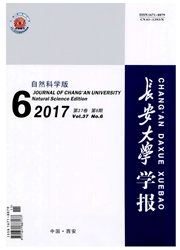

 中文摘要:
中文摘要:
为了对氯离子侵蚀下在役钢筋混凝土桥梁进行全寿命预测,需要选择更为合理的混凝土锈胀开裂时间模型。分别应用单因素变化、多因素变化和敏感性指标对在氯离子侵蚀环境下的10个开裂时间模型进行敏感性分析,得到开裂时间tcr对各输入参数的敏感性大小,并确定出合适的模型。研究结果表明:3种敏感性分析方法的结果基本一致;单因素敏感性分析得出开裂时间tcr对钢筋锈蚀率icorr(jcorr)、锈蚀物密度ρr、氯离子渗透区域δ0、钢筋摩尔质量与锈蚀物的质量之比αm的敏感性较高,这4个参数属于模型中的重要参数;多因素敏感性分析得出tcr对icorr的敏感性增强,同时发现混凝土保护层厚度c、钢筋直径d和混凝土抗拉强度ft变化所引起的tcr变化率的改变也较为显著;敏感性指标分析得出参数c、d和ft的敏感性较单(多)参数分析略有提高;包含以上7个参数,确定文献[4]提出的模型8为适于工程应用的合理模型。
 英文摘要:
英文摘要:
In order to predict the full life of existing reinforced concrete bridge affected by chloride contamination, a more reasonable time model of concrete corrosion cracking needs to be selected. Univariate changes, multivariate changes and sensitivity index were used to analyze the ten con- crete cover cracking time models under the condition of chloride contamination environment, and the sensitivity of cracking time tcr to each input parameter was obtained. Then, the appropriate cracking time model was determined. The results show that the results of three sensitivity analy- sis methods are almost consistent. Univariate sensitivity analysis shows that tcr has higher sensi- tivity for i (j ) ,ρr ,δ0 ,am, which belongs to four important parameters in the model. Multiva- riate sensitivity analysis shows that the sensitivity of tcr to icorr increases, and the change rate of tcr caused by the changes of c,d and ft is also notable. Analysis of sensitivity index shows that sensitivites of c,d and ft are slightly elevated. Considering the seven parameters above, this pa-per concludes that the model eight proposed by Liu and Weyers is reasonable model for engineer- ing applications. 4 tabs, 7 figs, 25 refs.
 同期刊论文项目
同期刊论文项目
 同项目期刊论文
同项目期刊论文
 Seismic Response Analysis of Substation Involving Interaction of Main Structure - Electrical Equipme
Seismic Response Analysis of Substation Involving Interaction of Main Structure - Electrical Equipme Experimental investigation of corrosion induced cover cracking of concrete containing mineral admixt
Experimental investigation of corrosion induced cover cracking of concrete containing mineral admixt 期刊信息
期刊信息
